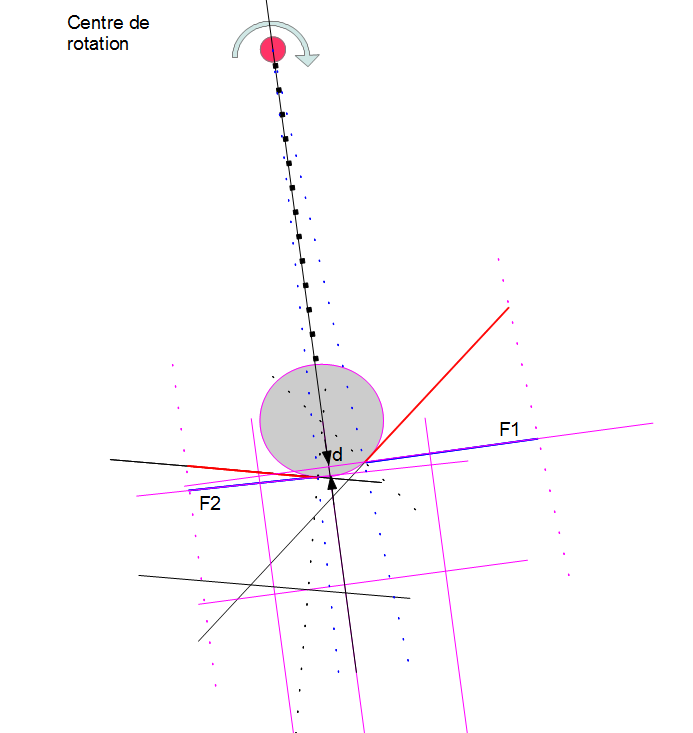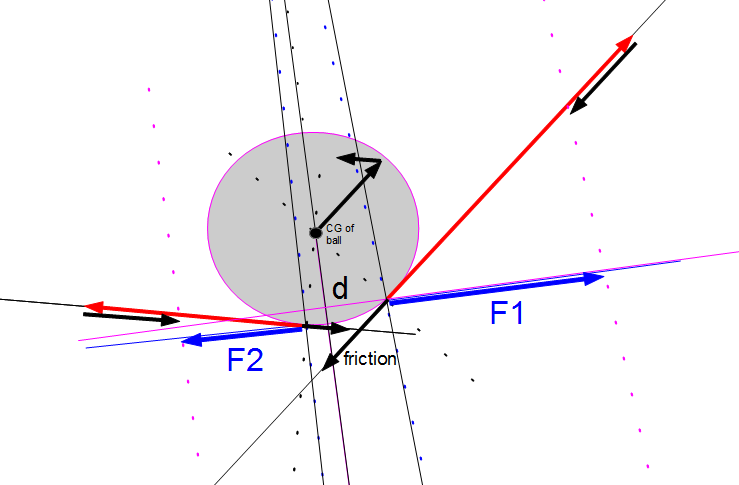A sphere (grey color) turn in rotation at $\omega$ rd/s. There are 2 walls that prevent sphere to escape. Walls can only turn around center of rotation. The sphere turn only at $\omega$ rd/s too. The center of gravity of sphere is the center of circle. The center of gravity of {system less sphere} is red point. Two forces on walls give a torque. Magenta force is centrifugal force. Red forces = magenta force on walls. F1 and F2 are forces perpendicular on radial axis, there are projection, there are not friction.

I done the resolution with the projection in each axis. There is a difference on $d$ but very little difference, sure forces F1 and F2 change in the same time. I drawed new projection:

If I add friction, this change the equilibrium, this don't change $d$ nor $R$ so like friction can be different on interface sphere/wall1 and sphere/wall2, how can I have a sum of torque at zero ?
I drawn all forces with friction:

I give same friction like that sphere don't turn. I hope I can do that, I'm not sure. I exagerate the size of friction for look with good precision. Forces F1 and F2 changed. I suppose sum of torque is at 0 before friction. I suppose the center of gravity of {system except sphere is red point} and I suppose the center of gravity of sphere is in the center of circle (black point). Friction give torque to {system - sphere} and give the same torque to sphere (in other direction). But forces apply to the center of gravity, no ? So for me the torque on sphere is lower than the torque give to {system - sphere}. What's wrong ?
If I give different friction on wall1/wall2. This would say the sphere turn ? If the sphere turn it's on its center of gravity. So this rotation transmit/cancel energy to the rest of the system ? This transmission of energy is from center of gravity of ball to external wall1/2. How torquescan cancel themselves ?

With friction I done simulation for look at sum of forces. Green color: sum of forces are not collinear, the software shows a global torque. Maybe it done the same error like me with center of gravity. If you could explain where forces act: on which center of gravity ?

Pieces 1 are link together (it's one piece). Piece 2 is alone. The system turn clockwise. Friction is at 0.5. If I added weight to (A) this move the center of gravity of (1), and the torque increase more. The weight of pieces are:
Big circle: 15 kg
Small circle: 0.6 kg
Big stems: 0.7 kg
Small stem: 0.2 kg
Maybe the software is not precise enough. But when I look at forces I can understand the torque increase more and more. So what force is false ?
I simulated with a lot of parameters. Frequency change results until 4800 Hz. From 4800 Hz to 12000 Hz results don't change (below 3%). From 9600 to 12000 Hz I can't measure the difference. Big circle turn around its center (center of the circle). Small circle turn around its center (center of the circle) too.
I have isolated 5 cases:
First:
The most common : here the system win energy

Second:
Sometimes: I can't say if system win or lost energy because it's too short

Third:
It depend, this is the most difficult to say, with x rd/s it's sometimes (less than first case), with y rd/s it's often (more than first case). The energy is lost or win, it depend. But that I find strange, it's the energy. Angular energy is lost (the torque must increase angular energy in this case) but linear velocity increase sometime more sometime less than angular velocity.

Forth:
Very rarely (very less often than second case), I estimated this case like 20 cases on 12000 cases in a turn: Here the system lost energy. The energy lost is important because I can see it even the forces appears very quickly.

Fifth:
Sometimes: I can't say if the system win or lost energy. No forces N.
If you can explain each case ? I would like to understand forces and why energy move up/down. The case 4 is a bug I think, but it lost energy don't win. Maybe in the first case the software add energy but in fact the system lost.
I think I understood something but I'm not sure:
In the following case (it's the same case than before but with more straight surfaces for show if it was not the mesh of Algodoo, but not and I added an axis for show if there is the same problem with energy and it is even energy increase slowly):

With forces like that:

In Algodoo the free big circle turn around itself. It's logical that big circle in free rotation receive a torque on it. This torque act in its center of gravity. Forces act on another object from axis, like radius is not the same the torque is not the same and energy too I think. I resume forces like that:

Energy can be like that:

Some datas:

What do you think about that ? Free big circle can turn around itself with a particular forces on it, yes/no ? If yes, these forces are apply in its center of gravity, yes/no ? And these forces don't work in the same value to other object due to the difference of radius, yes/no ?
I added angular velocity of 2 objects, there are not the same (never), there is always a difference of 0.1 rd/s. It's possible to see the object 2 turn around itself with software. I tested with Comsol and with Algodoo, the angular velocity is not the same. And even I force the angular velocity of object 2 at the same value than object 1, some seconds after angular velocity return to the previous values. If there is a difference for angular velocity this could say torque from friction don't work the same value for 2 objects and maybe it's the reason software can give more and more energy even all the system turn alone.





